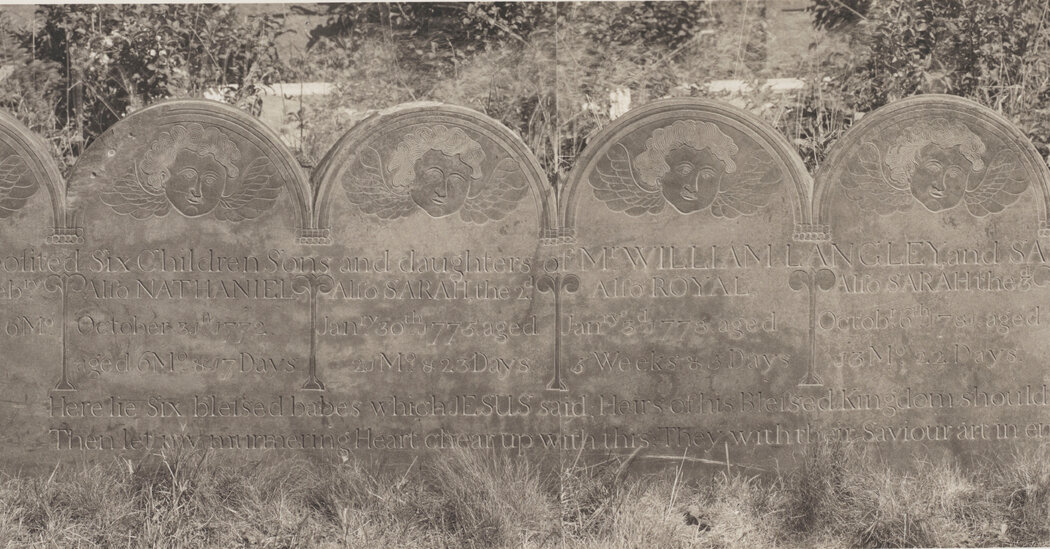
PHILADELPHIA — Is technical wizardry enough to make someone an artist?
Richard Benson was unrivaled as a printer of photographs before he became a photographer. Hired in his early twenties by an art-book printing company to make halftone negatives to run on an offset press, he realized, as he later wrote, “I couldn’t understand printing without first mastering photography, and so my career began.”
At the time of his death at 73 in 2017, Benson profoundly understood the processes and techniques of photographic printing. He was also a beloved professor and dean at Yale. His own work with a camera, however, received less attention. “The World Is Smarter Than You Are,” an exhibition through Jan. 23 at the Philadelphia Museum of Art, is his first museum retrospective. (The title is one of his favorite adages.)
There can be no argument about his prowess. One of his early pictures, “John Bull’s Great Stone, Common Burying Ground, Newport, Rhode Island” (1973-78), was made with a large-format view camera and composed of two contact prints mounted side by side. It depicts a series of six headstones for babies in one family, each marker incised with the face of an angel. Benson descended from a family of Newport stone carvers that dated to Colonial times. This composition, framed with perfect symmetry and sharp as a scalpel, is almost palpable, an appreciative flourish across the centuries from one consummate craftsman to another.
In black-and-white and color, in film and digital, in platinum prints, offset lithographs and inkjet prints, Benson mastered the procedures and, when he found them inadequate, invented his own. Like those sonically stunning LPs that were recorded to demonstrate the range of the first generation of stereos, Benson’s photographs often seem designed to mark the outer limits of what photography can practically achieve.
For reproducing photographs in a 1985 book devoted to the extraordinary Gilman Paper Company Collection (later acquired by the Metropolitan Museum of Art), he amplified the duotone process, where ink is passed through a fine mesh screen to impart subtle shades of black, gray and even, for older photographs, purple and sepia. The technique also allowed him to enlarge a negative without sacrificing detail. “Fall River Boiler,” a black-and-white image that he photographed in 1978 and printed a decade or so later, is a nocturne of texture and tone: feathery asbestos, gloppy encrustations, circular black holes.
Benson was just as proficient in color. “Georgia” (2007), which portrays a vertical array of four signs — two red octagonal stop signs, two circular railroad crossings, in yellow and orange — makes a visual counterpoint to three storage silos in the background that are painted red, blue and yellow-embellished silver. But the most virtuosic turn is the rendition of the sky, which is bleached out to a pale blue-gray at the horizon and gradually darkens to a full-throated cerulean at the top. If, as Willem de Kooning once remarked, flesh was the reason oil paint was created, Benson in his many crepuscular photographs makes the case that twilight skies were the reason color film was invented.
He started color photography in earnest in the early ’90s, and soon embraced digital photography. Finding the prevailing methods of color printing to be wanting, he innovated a procedure of inkjet printing in which, as in his lithography, he ran the sheet through the printer several times, applying the blacks and colors in layers. It is a little like the dye-transfer printing used by William Eggleston, but the colors are less saturated and the process less laborious. The reflections in a lake, the roseate ribbon of a sunset, the rainbow created as light passes through an irrigation mister — all are rendered with poetic precision.
In some of Benson’s black-and-white photographs of building interiors, like “65 Kenyon Street, Hartford, Connecticut” (1974), I thought of Walker Evans. Edward Weston floated into my consciousness as I looked at the organic semi-abstraction of “Agave” (c. 1975-85). And it was hard to avoid recalling Eggleston in viewing the color jolts of the vintage red truck in “Wyoming” (2008), or the lime-green rowboat in “Newfoundland” (2006-8).
Walking through the show, I saw the work of someone thoroughly imbued with the tradition, science and artistry of photography. But I was also reminded of a remark by Henry James, in a letter from 1888, about John Singer Sargent, who, similarly, could achieve with a brush anything he asked of it. “Yes, I have always thought Sargent a great painter,” James remarked. “He would be greater still if he had one or two little things he hasn’t — but he will do.”
Richard Benson: The World Is Smarter Than You Are
Through Jan. 23, Philadelphia Museum of Art, 2600 Benjamin Franklin Parkway, Philadelphia, (215) 763-8100; philamuseum.org.



